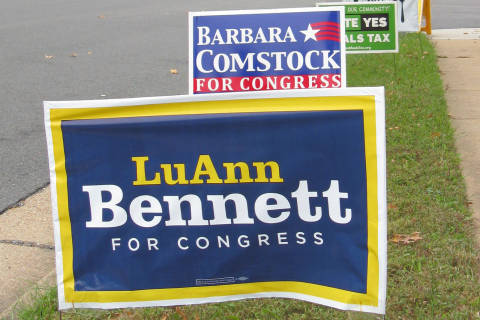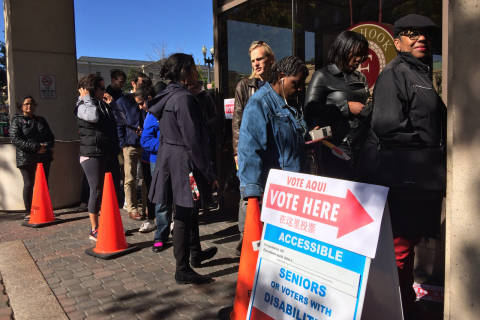Editor’s note: This article is part of a WTOP series previewing races and ballot measures and providing voting information for residents of D.C., Virginia and Maryland.
WASHINGTON — On Election Day in Maryland, the fate of nearly $200 million in funding for transit projects — the Purple Line included — will be left to local voters, whose decisions could also change the makeup of their governing bodies.
WTOP has rounded up some of the major issues that will appear on the Nov. 8 ballot as local referendums. A full list of all the ballot questions is available at the Maryland State Board of Elections website.
In Montgomery County, a petition drive led to a ballot question on setting term limits for County Council members and the county executive — a measure that could guarantee the ouster of nearly half the county council next term, if approved by the county’s voters.
Prince George’s County was the only region within WTOP’s primary listening area with bond referendums on the ballot. One of those is a funding request for nearly $200 million to help pay for transit and public works projects, including the contentious Purple Line project. County residents also are being asked to vote on adding two at-large members to the nine-member council.
Prince George’s County
Prince George’s County has seven questions on the ballot; five of them are bond referendums. In Maryland, certain counties let voters determine whether their county governments can raise money for major projects through the sale of bonds.
The largest of Prince George’s bond requests seeks nearly $200 million for public works and transportation projects, including the Purple Line.
The 16-mile light rail transit system would connect New Carrollton, in Prince George’s County, with Bethesda, in Montgomery County; 11 of the 21 stops would be in Prince George’s County.
County budget officials said last year that the county intended to seek bonds to cover its $120 million contribution to the project — total costs are projected to reach $5.6 billion. Montgomery County has been asked to contribute $210 million. Additional money will come from the state and federal government. Construction could begin as early as this year.
Here’s how this question will appear on the ballot:
Question E
(CB-43-2016)
Public Works and Transportation Facilities BondsAN ACT enabling the County to borrow money and issue bonds in an amount not exceeding $199,263,000 to finance the design, construction, reconstruction, extension, acquisition, improvement, enlargement, alteration, renovation, relocation, rehabilitation or repair of Public Works and Transportation Facilities (including roads and bridges, parking lots, and maintenance facilities), as defined therein.
For the Charter Referendum
Against the Charter Referendum
Adding at-large members to the County Council
Several Prince George’s referendums aren’t bond-related but, instead, would amend the county’s charter.
One of the referendums, Question D, asks voters to decide whether the County Council should add two at-large seats. This would expand the council to 11 members: nine members who would represent geographical districts and two at-large members who would represent the entire county.
In Prince George’s County, council terms last for four years; the current term expires in 2018. If this ballot question is passed, any district council member could seek an at-large seat — even district members who will have reached the county’s two-term limit by 2018.
According to a county audit, adding the council members would cost $831,000 in 2019 and $1.1 million in 2020. Neighboring Montgomery County has four at-large members on its nine-member council.
Here’s how this question will appear on the ballot:
QUESTION D
Charter Required Referendum
(CB-40-2016) (DR-2)
Proposed Charter AmendmentTo provide for the election of council members by district and at large, to change the composition of the County Council to a system of nine district members and two at large members, and to provide that a Council member who has been elected to two consecutive terms of office as a district member shall not serve more than two consecutive terms as an at-large member.
For the Charter Referendum
Against the Charter Referendum
Montgomery County
Montgomery County has three ballot questions, including one prompted by a petition calling for term limits.
If voters approve Question B, the county executive and County Council members would be limited to serving three consecutive terms. In Montgomery County, the terms last for four years; the current term ends in 2018.
County Executive Isiah Leggett would be affected if the referendum passes; however, he has said he plans to retire.
This amendment could also dramatically change the composition of the County Council for the next term, opening up seats to nearly half of the nine-member body. Four council members would be barred from seeking another term; another council member who began on a partial term could also be barred from seeking re-election.
At least 10,000 signatures from registered voters were needed to put this change before voters. According to the county election board, 17,649 signatures were submitted, of which 12,573 were valid.
In response to the petition, the County Council has placed a charter amendment on the ballot, Question C, that clarifies what constitutes a full term for County Council and county executive. As written, Question B treats a partial term like a full term. If Question C is passed, a partial term could only count as a full term if a person served for at least half the time.
Here’s how the questions will appear on the ballot:
QUESTION B
Charter Amendment by Petition
Term Limits — County Council and County ExecutiveAmend Sections 105 and 202 of the County Charter to:
–limit the County Executive and members of the County Council to 3 consecutive terms in office;
–provide that a County Executive and any member of the County Council who will have served 3 or more consecutive terms on December 3, 2018, cannot serve another successive term in the same office; and
—provide that service of a term includes complete service of a full term and partial service of a full term.
For
AgainstQUESTION C
Charter Amendment by Act of County Council
Term of Office — County Council and County Executive — Partial Service of a Full TermAmend Sections 105 and 202 of the County Charter to provide that partial service of a full term for either a Councilmember or the County Executive means service of more than two years of a term.
For
Against
Constitutional Amendments
Maryland voters will also be asked to ratify an amendment to the state’s constitution. The amendment would update the procedures to fill vacancies for the elected positions of state attorney general and comptroller.
The new process would be the same for appointing a U.S. senator and allows the governor to make the appointment. The appointed person would serve out the remainder of the four-year term, except that a special election would be held “if the vacancy occurs early enough in the term to allow for candidates to participate in the regular elections held in the second year of the vacating official’s term,” the Board of Elections says.
The state Senate would have to confirm a new comptroller’s appointment.
Read more about the proposed changes here.







